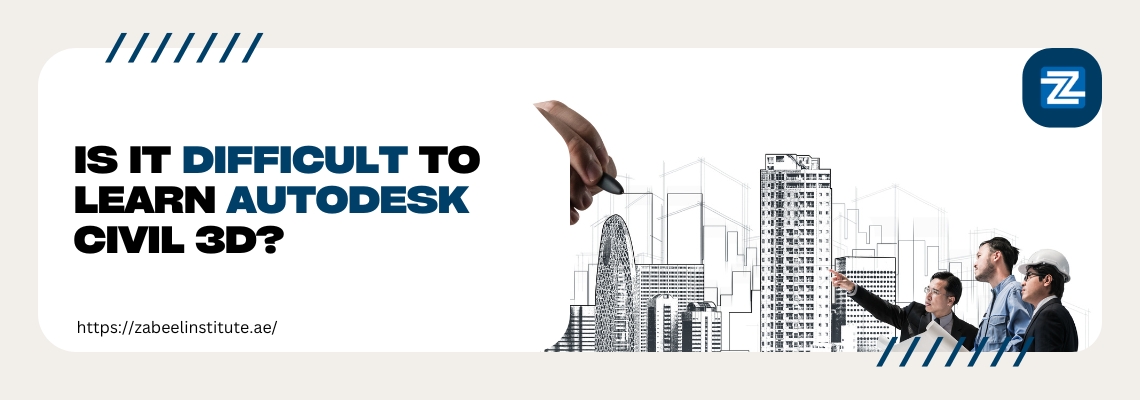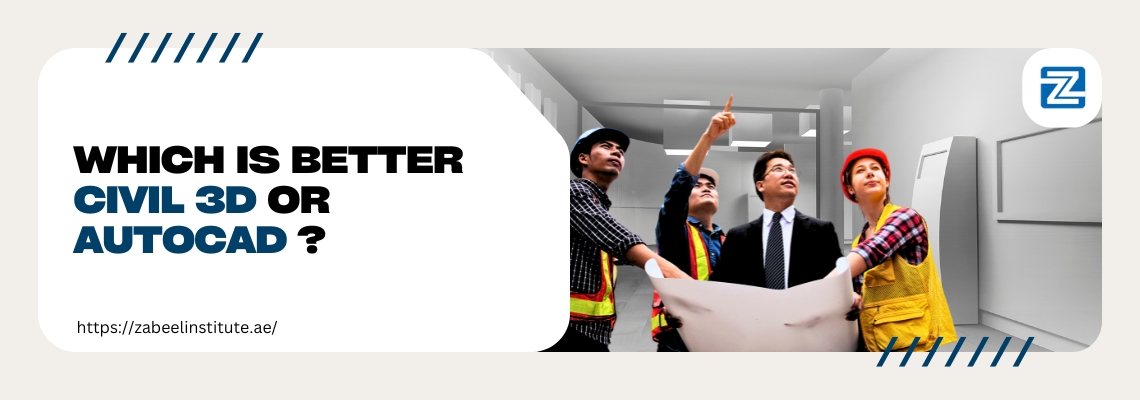Is it difficult to learn Autodesk Civil 3D?
In the evolving landscape of civil engineering and infrastructure design, Autodesk Civil 3D stands as a powerful tool that has transformed how professionals approach project development. As experts at Zabeel Institute, we’re often asked: “Is it difficult to learn Autodesk Civil 3D?” This comprehensive guide addresses this question while providing valuable insights into the learning journey.
Autodesk Civil 3D Software is a sophisticated design software specifically developed for civil engineering projects, offering comprehensive tools for surveying, road design, land development, water management, and infrastructure planning. While powerful, the software presents a unique learning curve that merits examination.
The perception of difficulty often stems from Civil 3D comprehensive nature—it’s not merely a drawing tool but an intelligent modeling system with dynamic relationships between design elements. This intelligence creates exceptional efficiency but requires understanding its fundamental concepts.
Factors Influencing the Learning Experience
- Previous CAD Experience
- Technical Background
- Learning Resources Available
- Project Complexity Requirements
- Learning Approach and Methodology
1.Previous Software Experience
Engineers and designers with prior experience in AutoCAD 2D training typically find certain aspects of Civil 3D more approachable. The interface shares similarities with standard AutoCAD, providing a familiar starting point. However, Civil 3D’s parametric nature and specialized civil engineering functions represent a significant leap forward in capability and complexity.
2.Technical Foundation
Your background in civil engineering concepts significantly impacts your learning trajectory. Professionals with a solid understanding of design principles, surveying methodology, and engineering calculations can more readily grasp how these translate into Civil 3D’s workflow. The software becomes less about learning buttons and more about implementing familiar concepts through new digital tools.
3.The Reality of the Learning Curve
Civil 3D learning typically progresses through several distinct phases:
- Interface Familiarization (1-2 weeks)
- Basic Drawing and Editing (2-4 weeks)
- Understanding Dynamic Modeling (1-2 months)
- Specialized Application Mastery (3-6 months)
- Workflow Optimization (Ongoing)
The initial interface learning phase can be streamlined through structured courses like those offered at the AutoCAD course in Dubai through Zabeel Institute, where focused instruction reduces the time needed to become operational.
Key Challenges and Solutions
1.Challenge: Complex Interface and Workflows
Civil 3D presents users with numerous toolsets organized in context-sensitive ribbons. This organization, while logical, can overwhelm new users.
Solution: Start with essential tools rather than attempting to master everything simultaneously. Focus on your specific discipline requirements first, then gradually expand your knowledge base. Structured learning paths at Zabeel Institute guide users through this progressive approach.
2.Challenge: Dynamic Relationship Management
The software’s intelligent objects and relationships between elements (like surfaces affecting corridor designs) represent a paradigm shift from traditional CAD.
Solution: Invest time in understanding fundamental concepts like object styles, labels, and dynamic relationships before diving into complex projects. Conceptual understanding pays significant dividends in long-term proficiency.
3.Challenge: Project Setup Complexities
Proper project setup critically affects workflow efficiency and collaboration capabilities.
Solution: Learn standardized templates and settings management early in your training. Zabeel Institute’s project-based learning approach emphasizes these foundational elements to establish proper workflows from the beginning.
Professional Development Path
For those seeking professional recognition, pursuing an AutoCAD certification provides validation of your skills while establishing credibility in the job market. Certification programs offer structured learning paths that systematically build competency.
The optimal learning approach combines:
- Structured Course Instruction
- Hands-on Project Application
- Mentorship and Community Support
- Progressive Challenge Escalation
- Continuous Learning Resources
1.Specialized Areas Requiring Focus
Civil 3D encompasses several specialized domains, each with distinct learning requirements:
2.Survey and Point Management
Understanding point creation, import/export, point groups, and description keys forms the foundation for site development work. This typically requires 2-3 weeks of focused practice.
3.Surface Modeling
Creating, editing, and analyzing terrain models represents one of Civil 3D’s core strengths but demands thorough understanding of surface properties and editing techniques. Expect 3-4 weeks to develop competent surface manipulation skills.
4.Corridor and Road Design
Road design functionality integrates multiple Civil 3D concepts including alignments, profiles, assemblies, and corridors. This integration makes road design among the more complex aspects to master, typically requiring 4-6 weeks of dedicated study.
5.Pipe Networks
Water, storm, and sanitary system design tools allow for intelligent modeling of underground infrastructure but require understanding of both software functionality and engineering standards. Plan for 3-5 weeks to develop foundational competency.
6.Reality-Based Time Investment
Becoming operational with Civil 3D’s basic functionality typically requires 40-60 hours of focused learning. Achieving intermediate proficiency where you can complete standard projects independently generally demands 120-180 hours of combined instruction and practice. True mastery, where you can optimize workflows and handle complex design challenges, develops over 6-12 months of regular application.
Optimal Learning Strategies
Based on our experience training thousands of professionals at Zabeel Institute, we recommend these proven approaches:
- Begin with guided instruction through structured courses
- Focus on completion of small, achievable projects
- Progressively increase project complexity
- Join user communities for troubleshooting support
- Establish mentor relationships with experienced users
- Document learned workflows for future reference
- Regularly practice newly acquired skills
- Apply learned techniques to real-world scenarios
Industry-Specific Applications
Civil 3D proficiency translates differently across various industry sectors:
- Land Development – Focus on parcel creation, grading, and earthwork calculations
- Transportation – Emphasize alignment design, corridor modeling, and intersection creation
- Water Resources – Prioritize watershed analysis, channel design, and hydraulic modeling
- Municipal Engineering – Balance multiple disciplines while focusing on standards compliance
- Surveying – Master point cloud handling, surface creation, and legal description generation
Training Facility in UAE: Dubai, Sharjah
If you are looking for Autocad Civil 3D Training online or offline in Dubai , you are reading the right article. Zabeel Institute has designed the Best Autocad Civil 3D Training in Dubai.
This certification offered by Zabeel Institute stands out from other training in the market.
Our exam result and pass percentage at Zabeel Institute is very high, which is increasing daily under the trainer’s constant support and guidance. Zabeel Institute is well known for delivering several successful batches of Autocad Civil 3D Training Courses. Zabeel ensures to help all students with all sorts of assistance for their brilliant performance in the exam.
This Institute, established in 1988, is a leading Educational and Training Institute for executives in Dubai. This Institute is by the KHDA and Ministry of Education UAE. We offers training programs to professionals from various industries like Airlines, Travel & Tourism, Engineering, Construction, Accounts and finance, Information Technology, Logistics, Languages, and Management. Zabeel’s career-specific courses are imparted through interactive teaching techniques, state-of-the-art technology, and experienced and highly qualified faculty.
More than 32 Years of Experience in training Professional Executives
- Achiever of many QUALITY AWARDS for training from 1988 till date
- Qualified & Certified Trainers
- Sophisticated lab with high-end machines and licensed software
- Certificates attested by the Ministry of Education, UAE
- Vast resource materials for reference and course materials
- Free online support for further assistance
- Free follow-up orientation seminars & workshops
- Integrated Training & Career Development Plan
Please visit the KHDA website to learn more about Zabeel :
https://www.khda.gov.ae/en/directory/training-Institutes-search-results/training-institute?id=156
Recommendation:
Zabeel Institute helps you get based on your education and experience and will further guide you to the certification.
To know more about these civil 3d course fees, exam costs, cissp exam fees, certification, general certification costs, and more, please Contact Zabeel Institute!
Zabeel offers Autocad Civil 3D Training in Dubai,
For further information please contact:
Tel: 600 52 4448, 00971 4 3974905
WhatsApp number: +971 503068426
Email: mail@zabeelinstitue.ae
Website: www.zabeel-international.com
Facebook: https://www.facebook.com/zabeel.international/
LinkedIn: https://www.linkedin.com/school/5954667/
Twitter: https://twitter.com/zabeel_intl
Instagram: https://www.instagram.com/zabeel_international/
To know more about Autocad Civil 3D Training in UAE,
Conclusion:
Civil 3D can seem complex at first, but with the right training and consistent practice, it’s entirely manageable. Most learners gain proficiency in 2–3 months through a structured approach. At Zabeel Institute, we’ve helped many turn this challenge into a career asset. With the right support, Civil 3D becomes a valuable skill that sets you apart in today’s infrastructure design field.















Recent Comments